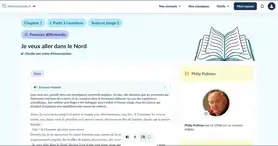Unit 14
Activity 4
Can humans coexist with the Earth?
Ressource affichée de l'autre côté.
Faites défiler pour voir la suite.
Faites défiler pour voir la suite.
Picture

Ressource affichée de l'autre côté.
Faites défiler pour voir la suite.
Faites défiler pour voir la suite.
Text A
Industries that are designing means of production can follow the example of nature in which
one species' waste is another's opportunity. A
plant that utilizes energy from the sun to grow and
reproduce may also nourish a host of parasites and
herbivores and upon dying feed still other lifeforms while returning organic material to the soil
to nurture future generations of plants. Material is
used, transformed and used again in a never-ending cycle. Nature has evolved exquisite mechanisms to survive and flourish over the vast expanse
of time as the Earth has undergone geological and
climatological change. Our scientific insights are
profound, but we are still at an early stage of
unlocking nature's secrets when technology is
powerful but crude. Too often we lack the
knowledge to anticipate the consequences of our
manipulations, as we have learned with nuclear
energy, DDT, CFCs and GMOs. [...] We can transform our thinking from the linearity of extracting,
processing, manufacturing, selling, using and discarding into the circularity of natural cycles.
The Sacred Balance: Rediscovering Our Place in Nature, David Suzuki, originally published in 1997, revised edition of 2007.
Ressource affichée de l'autre côté.
Faites défiler pour voir la suite.
Faites défiler pour voir la suite.
Text B
We need, Mc Donough argues, to pattern
our industries on nature, what is termed “biomimicry”. That means preventing waste by
limiting any sort of manufacturing or consumption that causes it. If any waste is created, it has
to be nonpolluting so that it can serve as “food”
for natural or industrial systems, just like dead
leaves or muddy water in nature. If your waste
can't be safely absorbed by natural systems or
fed back into industry easily, that's the proof
that your methods don't accord with nature's,
that you're losing part of your investment and
causing damage. Indigestible wastes like toxic
chemicals or heavy metals also destroy natural
systems' ability to produce more products in the
future. Let's go over a full list of what's required
to survive on this planet over the long term. To
be sustainable, any industrial or infrastructure
development, any business or management
model, whether it manages factories, farms,
wild animals, or water resources, has to mimic
nature, or it won't fit in with the laws of physics. It has to, above all, be local. It must not
produce any wastes that cannot be harmlessly
absorbed by natural systems. If it does, it has to
reintegrate that waste into the industrial
stream. Like natural systems, sustainable management must be self-regulating, nonhierarchical, cyclic, flexible, diversified—and focused on
the long term.
More Good News: Real Solutions to the Global Eco-Crisis, David Suzuki, 2010.
Ressource affichée de l'autre côté.
Faites défiler pour voir la suite.
Faites défiler pour voir la suite.
Questions
You are in charge of one text.
1
Present the text. 2
What definition of biomimicry is given? 3
What suggestion(s) does David Suzuki make about how
industry should evolve? Useful vocabulary
a sustainable system must be + adj…
To be sustainable, you should + V.
Let's talk this out!
Group work
4
Recap David Suzuki's ideas. Discuss whether you
agree with him or not.
5
How can biomimicry influence industries? Save
the planet?
Useful vocabulary
I agree with… I don't agree with…
What strikes me the most is…
In order to save the planet, we have to…
What strikes me the most is…
In order to save the planet, we have to…
Ressource affichée de l'autre côté.
Faites défiler pour voir la suite.
Faites défiler pour voir la suite.
Over to you!
Ressource affichée de l'autre côté.
Faites défiler pour voir la suite.
Faites défiler pour voir la suite.
Une erreur sur la page ? Une idée à proposer ?
Nos manuels sont collaboratifs, n'hésitez pas à nous en faire part.
j'ai une idée !
Oups, une coquille


